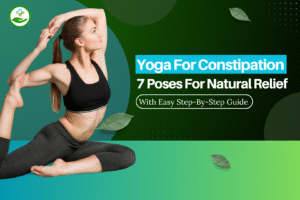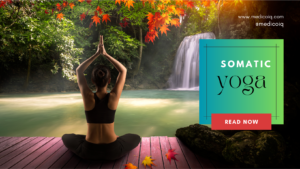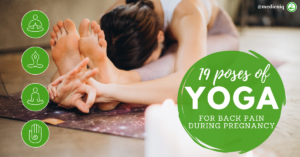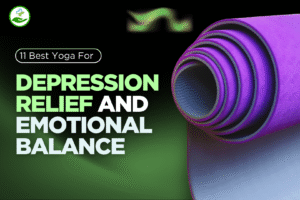In today’s fast-paced world, stress is an unavoidable part of life. Work deadlines, family responsibilities, and the constant digital buzz can leave us feeling drained. Fortunately, there’s a powerful yet gentle way to calm your mind and rejuvenate your body 30-minute yoga for beginners.
You don’t need to be flexible, athletic, or experienced to benefit from yoga. Just a few minutes each day can make a big difference in your mood, mental clarity, and overall well-being.
In this post, we’ll explore how a short daily yoga routine can relieve stress, beginner-friendly poses to try, and tips to help you get started all within 30 minutes.
Why Choose 30-Minute Yoga For Beginners?
Quick & Effective Stress Relief
Even a short yoga session can help reduce stress hormones like cortisol. When you focus on breath and movement, your nervous system begins to shift from “fight or flight” to “rest and digest,” helping you feel more relaxed almost immediately.
Ideal For Busy Schedules
One of the biggest advantages of 30-minute yoga is that it fits into even the busiest of days. Whether it’s before work, during lunch, or before bed, half an hour is enough to restore balance without feeling like another task on your to-do list.
Top Benefits of 30-Minute Yoga for Beginners
- Reduces anxiety and promotes mental calm
- Improves sleep quality and reduces insomnia
- Enhances mental focus and clarity
- Encourages body awareness and mindfulness
- Boosts mood and energy through gentle movement
- Supports cardiovascular health and reduces blood pressure
These benefits make 30-minute yoga for beginners a powerful daily tool for physical and emotional self-care.
Top 5 Beginner-Friendly Yoga Poses For Stress Relief
These simple poses are gentle on the body and highly effective in calming the mind. You don’t need special equipment just a yoga mat and a quiet space.
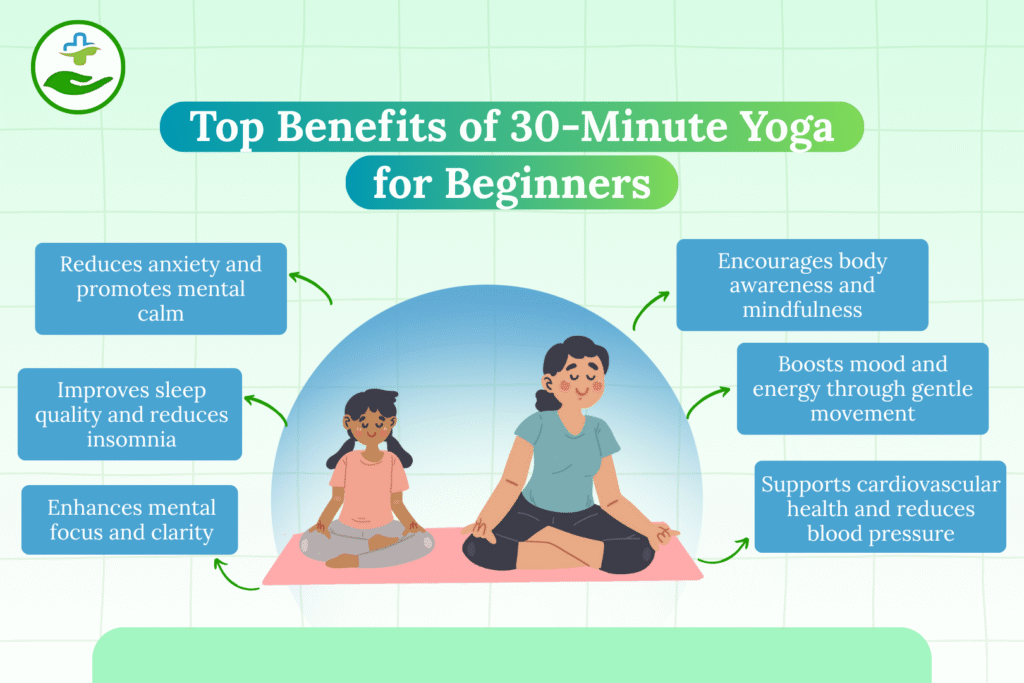
Child’s Pose (Balasana)
A deeply relaxing posture that gently stretches the back, hips, and shoulders.
Tip: Breathe deeply while resting your forehead on the mat.
Cat-Cow Stretch (Marjaryasana-Bitilasana)
A flowing movement between two poses that warms the spine and eases tension.
Tip: Sync your breath with each movement — inhale for cow, exhale for cat.
Downward-Facing Dog (Adho Mukha Svanasana)
Great for full-body stretching, improving circulation, and calming the mind.
Tip: Bend your knees slightly if your hamstrings are tight.
Seated Forward Bend (Paschimottanasana)
Helps release back tension and encourages introspection.
Tip: Focus on lengthening your spine, not how far you can reach.
Legs-Up-the-Wall (Viparita Karani)
A restorative pose that promotes circulation and stress relief.
Tip: Hold for 5–10 minutes for deep relaxation.
Completing this beginner yoga session can improve emotional balance. Learn even more about managing anxiety, enhancing focus, and staying emotionally resilient in our mental wellness guide.
Sample 30-Minute Yoga Routine For Beginners
Here’s a simple and effective 30-minute stress-relief flow you can follow at home:
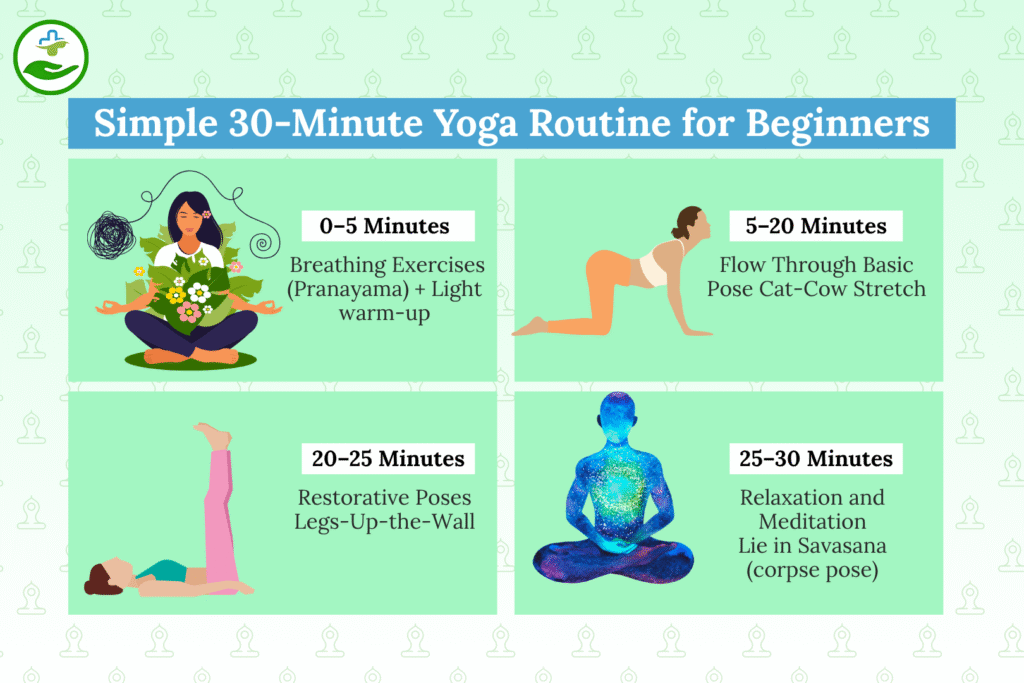
- 0–5 Minutes: Breathing Exercises (Pranayama) + Light warm-up
- Sit comfortably and practice deep breathing.
- Roll your shoulders and gently twist your spine side to side.
- Sit comfortably and practice deep breathing.
- 5–20 Minutes: Flow Through Basic Poses
- Cat-Cow Stretch
- Downward-Facing Dog
- Child’s Pose
- Seated Forward Bend
- Cat-Cow Stretch
- 20–25 Minutes: Restorative Poses
- Legs-Up-the-Wall
- Gentle spinal twists lying on your back
- Legs-Up-the-Wall
- 25–30 Minutes: Relaxation and Meditation
- Lie in Savasana (corpse pose)
- Focus on slow, deep breaths
- Optionally play calming music or a guided meditation
- Lie in Savasana (corpse pose)
Tips to Maximize The Benefits Of 30-Minute Yoga
Create a Calm Space
Dedicate a quiet corner in your home for your practice. Use soft lighting, calming scents, or a yoga mat to set the mood.
Focus on Your Breath
Conscious breathing is key to stress relief. Try inhaling for 4 counts, holding for 4, and exhaling for 6.
Stay Consistent
Make it a habit. Practicing regularly is more effective than doing long sessions infrequently.
Use Guided Videos or Apps
Not sure where to start? Many beginner-friendly apps and YouTube videos offer structured 30-minute yoga routines you can follow along.
Real-Life Story: How Yoga Helped Me Beat Burnout
Akansha, a 34-year-old graphic designer, started doing 30-minute yoga sessions at home after struggling with work-related burnout. “At first, I thought yoga was too slow for me,” She says. “But after just one week, I slept better and felt less anxious. I’ve now made it a daily ritual, and it’s completely changed how I manage stress.”
Conclusion
Stress is a part of life, but it doesn’t have to control your life. With just 30 minutes a day, 30-minute yoga for beginners can become your personal sanctuary a space to breathe, move, and let go. You don’t need fancy gear or years of experience. All you need is the willingness to start yoga for health and stress management (NCCIH).
Start your 30-minute yoga for beginners routine today — and let the stress melt away, one breath at a time.
Frequently Asked Questions
Q1. Is 30 minutes of yoga enough to reduce stress?
Ans- Yes! A consistent 30-minute practice can significantly lower stress hormones and improve your mental well-being.
Q2. Can beginners do yoga without prior experience?
Ans- Absolutely. The poses and flows shared above are designed for people with no previous experience.
Q3. How soon will I feel the benefits of yoga?
Ans- Some benefits, like relaxation and improved mood, can be felt immediately. Long-term results, like better sleep and reduced anxiety, often show within 1–2 weeks.


